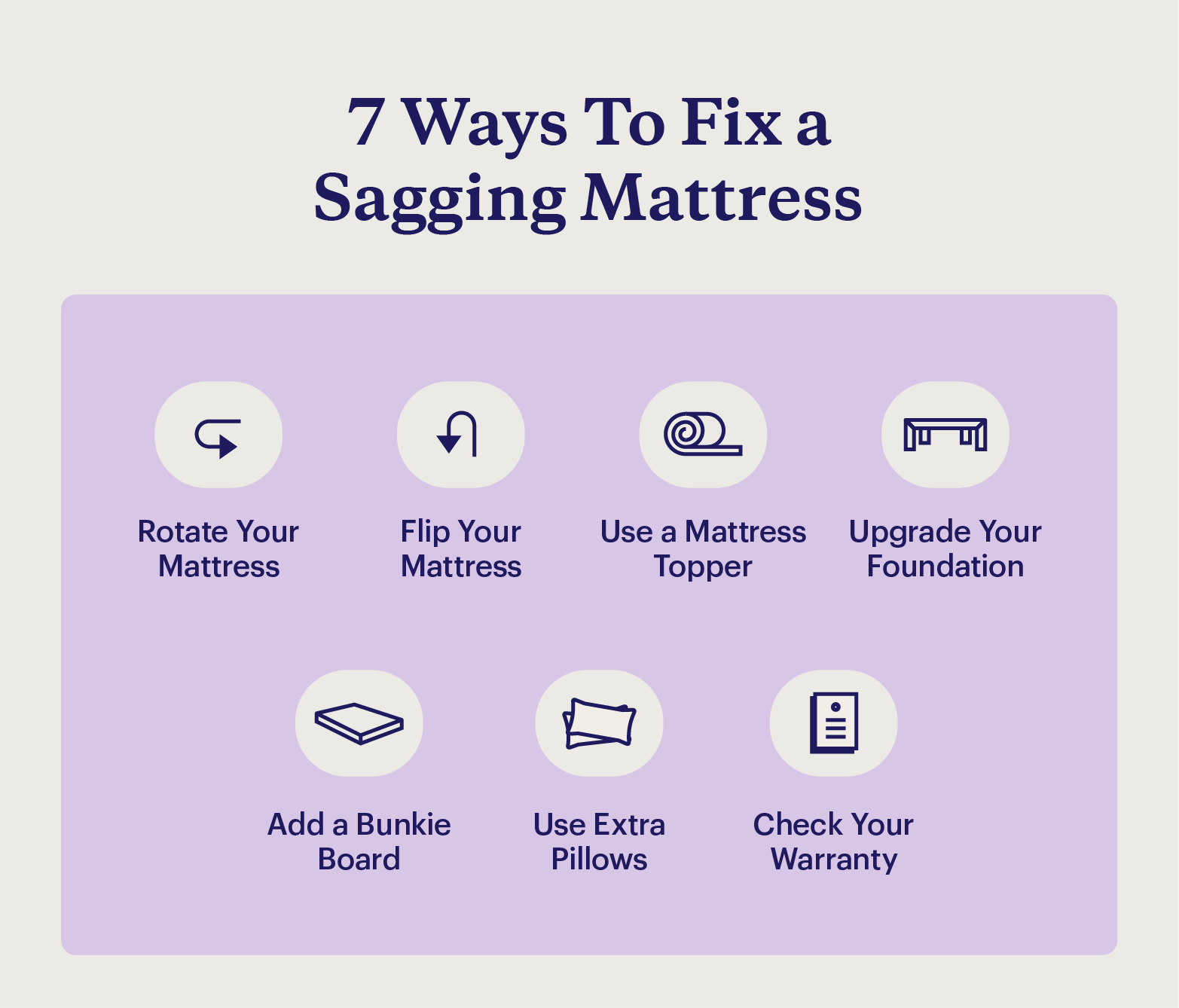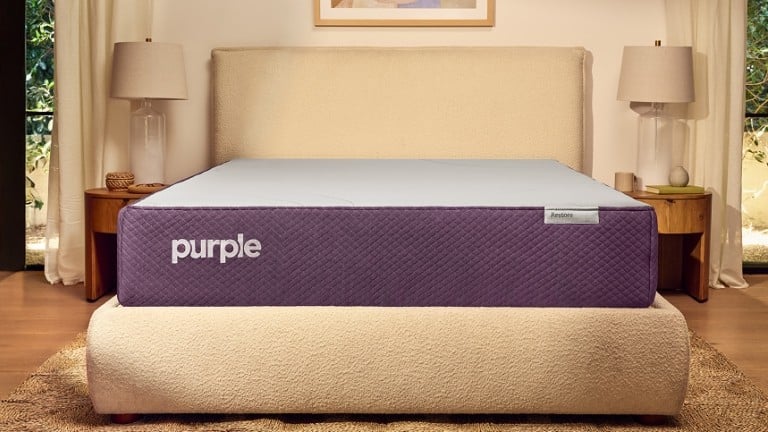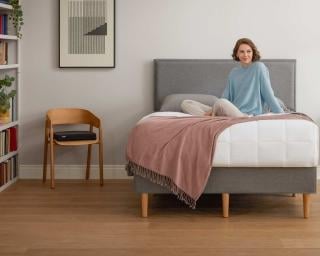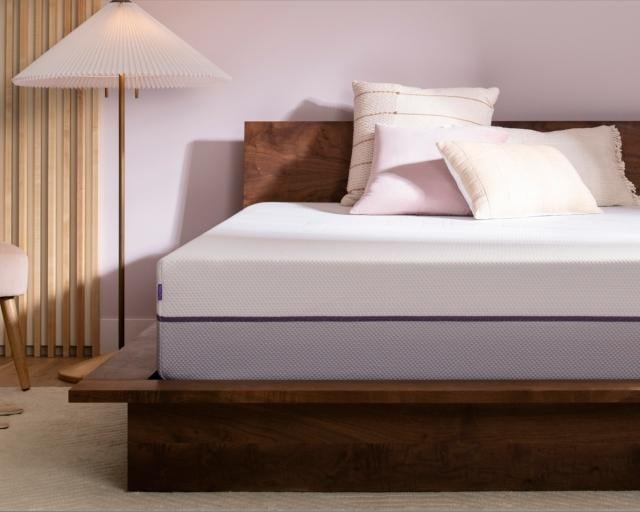
How To Fix a Sagging Mattress: 7 Methods + Prevention Tips
Key Takeaways
- Alleviate your sagging mattress by rotating or flipping your mattress, using a mattress topper, or upgrading your mattress base.
- While you can improve how a sagging mattress feels, you won’t be able to reverse the damage. If your mattress has started to sag, you may want to replace it.
Does it feel like you’re sinking into your mattress? You're not alone. Many people find that their mattresses sag over time. A sagging mattress can be uncomfortable, causing new aches and pains, disrupting your sleep, and harming your cognitive function.
If you’re wondering how to fix a dip in your mattress, the truth is that you won’t be able to restore your mattress once it’s started to sag. But there are methods you can use to prevent it from getting worse.
While you can extend your mattress’s life once it starts sagging, replacing your mattress is most recommended. Purple offers a variety of mattress options featuring our proprietary GelFlex® Grid, which is designed to provide adaptive support regardless of your sleep preferences.
In this guide, you’ll learn seven ways to mitigate mattress sagging, as well as how you can best support a mattress to reduce the risk of sagging in the first place.
1. Rotate Your Mattress Regularly
Rotating your mattress means reversing which end of the bed you lay your head and feet by rotating it 180 degrees. This allows you to distribute your weight more evenly across the surface. Rotating may also slow down the process of sagging if it has already begun.
Regularly rotating your mattress can extend its lifespan and reduce wear and tear. We recommend rotating your mattress every three to six months to limit sagging.
2. Flip Your Mattress
Depending on the type of mattress you have, flipping it may extend its life and reduce sagging. However, not all mattresses should be flipped. You should never flip the following mattresses:
- Purple mattresses
- Memory foam mattresses
- Latex mattresses
- Hybrid mattresses
- Pillow top mattresses
Mattresses with a coil structure may benefit from occasional flipping, as it can help maintain the necessary level of support and reduce sagging.
If you’re unsure whether you can flip your mattress or not, check the label or contact your manufacturer for more information.
3. Use a Mattress Topper
Mattress toppers are a layer of foam or other cushioning material you can put on top of a mattress for added comfort. If your bed is too firm, too lumpy, or generally uncomfortable, adding a mattress topper may make your mattress feel softer.
You can use a mattress topper to alleviate symptoms of sagging mattresses and keep you from experiencing back pain, sore shoulders, and other aches. Mattress toppers won’t fix your mattress, but using one can extend the life of your mattress and keep you more comfortable until you get a replacement.
4. Upgrade Your Foundation
It’s important to pair your mattress with the right bed foundation. An incompatible bed foundation can speed up the sagging process, especially for beds that make use of slats where unsupported areas are especially prone to sagging. If your mattress is starting to sag, upgrading your foundation may help slow the process.
Without proper support, all types of mattresses may be more prone to sagging. Memory foam mattresses that lack interior support tend to sag faster than innerspring and hybrid mattresses, but using a suitable bed frame or foundation can help mitigate this issue. A suitable foundation can also raise your mattress, making it easier for you to get in and out of bed.
Regardless of mattress type, choosing a foundation that provides stability and support can help extend the life of your mattress and reduce the risk of premature sagging.
5. Add a Bunkie Board
A bunkie board is a thin piece of plywood covered in plastic that is placed between the bed frame and mattress. Bunkie boards function similarly to box springs, providing additional support, stability, firmness, and equal weight distribution. If your mattress is starting to sag, adding a bunkie board may help your mattress keep its shape and structure.
Using a bunkie board may not be the best method to fix a sagging mattress, though. Plywood can be uncomfortable, even with a mattress on top. If you sleep hot, you may want to avoid bunkie boards. Placing a solid piece of plywood underneath your mattress limits airflow, contributing to heat retention.
6. Supplement With Pillows
For a quick fix, place some pillows in areas where your mattress has started to sag. This may help reduce any pain you might feel from sleeping on an uneven and unsupportive surface. You can also add pillows around your pressure points, including under your hips and between your knees, to reduce discomfort.
Whether you’re lying on top of your pillows or just resting your head on one, make sure you choose a pillow that provides the right amount of support and comfort for your needs. Remember that using pillows where your mattress sags is a short-term solution, and replacing your mattress is the only true solution when your mattress starts sagging.
7. Check Your Warranty
Many mattress warranties will cover sagging, especially if it’s premature and could compromise the mattress’s structure.
However, most manufacturers have specific criteria like the depth and severity of indentations that determine whether they will cover the cost of a replacement. Your mattress foundation can also affect whether manufacturers will cover sagging, as using an ill-suited base may void your warranty.
Before purchasing a new mattress, make sure to check the warranty. If your mattress is starting to sag, it’s often worth checking your existing warranty to see what’s covered.
Why Is My Mattress Sinking? 5 Common Causes
Mattress sagging usually feels like an uneven spot or dip in your mattress, particularly at points where your hips and shoulders rest. Over time, these pressure points leave indents in your mattress that can cause discomfort.
Mattresses may start to sag for several reasons. Five of the most common causes of mattress sagging include:
1. Poor Mattress Quality
Low-quality materials and subpar construction may cause your mattress to start sagging more quickly than others. A cheaper mattress may provide less edge support and break down faster, so if you’re experiencing premature sagging, the quality of your mattress may be part of the problem.
2. Wear and Tear
Sagging is a normal part of a mattress’s life cycle that happens over time as pressure is applied every night. This pressure causes the mattress to soften and gradually lose its structure, limiting the amount of support and pressure relief it can provide.
Innerspring and hybrid mattresses may start sagging when the metal coils lose their tension after years of use. For most mattresses, sagging is inevitable, but it typically occurs after years of continued use.
If your mattress is under seven years old and starting to sag, be on the lookout for other signs of a bad mattress like mold and dust mites, which may suggest it’s time to replace your mattress.
3. Inadequate Foundation
Using an old box spring or flimsy bed frame could make your mattress sag, especially if the base can no longer support the weight of your mattress. Wear and tear can compromise the effectiveness of a box spring or mattress foundation, making it less effective at evenly distributing your weight.
While there are different kinds of mattress bases, it’s important to choose one that provides the best support for the type of mattress you have. An unsupportive base can result in an uncomfortable, lumpy mattress.
Choose a mattress base like the Purple Foundation that provides the structural support and stability necessary to protect your mattress from premature sagging.
4. Sleep Habits
If your mattress is sagging on one side, your sleep preferences could be part of the cause. Sleeping on a particular side or spot night after night can put added pressure on your mattress in those areas, making it wear out more quickly.
Switching up your sleep position and rotating your mattress regularly can help alleviate this issue by distributing your weight across different areas.
5. Weight Distribution
The more weight and pressure you put on your mattress, the faster it will start to wear out and sag. If you sleep with a partner, your mattress may start sagging more quickly, especially if you sleep in the same spot every night. Heavier sleepers may notice more sagging. Allowing pets on your bed can also contribute to premature sagging and greater wear and tear.
Rotating your bed regularly may help reduce mattress sagging that results from unequal weight distribution. It’s also important to choose a mattress that offers the support you need to prevent your bed from breaking down and disrupting your sleep.
How To Prevent Your Mattress From Sagging
Most mattresses will start to sag over time, but there are ways you can make your mattress last longer without sagging prematurely. We recommend:
- Choosing a supportive mattress: You should sleep on a mattress that matches your preferences and supports your unique sleep needs. Ideally, you should choose a bed that adapts to your body as you move and provides contouring support for pressure point relief regardless of your sleep position.
- Using a suitable base: Use a sturdy, supportive bed frame or mattress foundation to help reduce sagging. Different types of mattresses need different bases, so be sure to choose one that provides enough stability for your mattress.
- Rotating your bed: Rotating your mattress every few months can help prevent excess weight and pressure from affecting the same areas of your bed.
- Switching up your sleep position: If you sleep in the same position and spot every night, your mattress may wear out faster in that area. Training yourself to sleep in different positions can reduce wear and tear and allow your mattress to last longer without sagging.
- Inspect your mattress: As you make your bed, check for signs of sagging in the form of dents or lumps. The sooner you detect sagging, the sooner you can make adjustments to prevent the damage from getting worse. You might also start looking into replacements so you can make an informed decision once your mattress is no longer comfortable and supportive.
In most cases, you can’t prevent your mattress from sagging, but you can provide proper support and adopt better sleep habits to extend the life of your mattress and reduce the risk of irreversible wear and tear.
Do Purple Mattresses Sag Over Time?
Purple mattresses are specially engineered to reduce sagging. All Purple mattresses come with our instantly adaptive GelFlex®Grid, a soft and supportive comfort layer made of Hyper-Elastic Polymer that reconfigures itself to support your body weight and move as you move. Its shape retention properties. Additionally, over 1400 individual air channels help dissipate body heat — something memory foam mattresses have a tough time doing.
All Purple mattresses are backed by a 10-year warranty that covers visible indentations and impressions of up to 1 inch, so if you do start to experience sagging, you can rest easy with Purple.
Don’t Settle for a Saggy Mattress: Upgrade With Purple
Mattress sagging is a common issue with older mattresses. If you notice signs of premature sagging, such as indentations that don’t go away, there are some things you can do to prevent further sagging.
While there are temporary fixes, a replacement mattress that better supports your body and therefore improves your sleep quality is the ideal choice.
Purple offers a wide range of mattresses for all sleeping positions and body types. Our proprietary GelFlex® Grid is the only sleep innovation of its kind that doesn’t make you pick between softness and support. With a patented design, it cradles pressure points like hips and shoulders while maintaining proper support everywhere else. The result? Ache-free, uninterrupted rest night after night.
FAQ
Mattresses usually sink due to natural wear and tear, though factors like an unsupportive base can make your mattress deteriorate more quickly. Over time, the foam and coils that are designed to support your body wear down, resulting in uncomfortable dips and lumps.
Once you start noticing sinkage, bumps, and creaking noises, or if you start to feel uncomfortable and have more difficulty sleeping, then it may be time to replace your mattress.
Like most mattresses, memory foam beds will sag over time. One-sided memory foam beds are especially prone to sagging because they tend to lack sufficient interior structure which is a typical component of innerspring and hybrid mattresses. A sagging memory foam mattress may cause discomfort in your back and other pressure points, which can disrupt your sleep.
Depending on the material, mattresses last upwards of seven years, so most mattresses shouldn’t show signs of sagging before that point. If your mattress is sagging prematurely and causing you discomfort, make sure you’re using a supportive base and check your warranty to see what’s covered.
A brand-new mattress should not sag at all, so if you’re experiencing this, you may need to replace your foundation to provide enough support. If your base seems sturdy, contact the manufacturer, as the mattress may be defective.
Using a mattress topper may improve the feel of your mattress, especially if it’s developing lumps or dips, but it won’t fix the problem. If your sagging mattress is uncomfortable even with a mattress topper, consider replacing it to improve your sleep quality.
There are no foolproof ways to fix a sagging mattress. Once a mattress begins softening, there isn’t much you can do to return it to its original shape.
However, there are many ways you can prevent further sagging, including flipping and rotating your mattress, adding a mattress topper, and using a more supportive foundation to improve the longevity of your mattress.
Aside from rotating and flipping your mattress, you can try fixing the indents on your bed by filling the gaps with pillows and using a bunkie board to prevent further sagging. Ultimately, if your mattress has started sagging and is affecting the quality of your sleep, you should look into replacement options.
More To Explore
Level up your sleep routine with our most-loved products.
Looking to find better sleep?
It all starts here — explore our mattress collections and find out why 98% of our customers would shop with us again.












